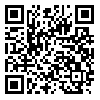BibTeX | RIS | EndNote | Medlars | ProCite | Reference Manager | RefWorks
Send citation to:
URL: http://ijn.iums.ac.ir/article-1-3537-en.html
2- Department of Nursing Management, School of Nursing and Midwifery, Iran University of Medical Sciences, Tehran, Iran.
Background & Aims Risk management in academic research, courses, and degrees is crucial in universities. However, there is no evidence for risk management in most aspects of university management. This study was conducted to determine the risk management Evaluation from the Staff's Perspective of Iran University Medical Sciences In 2021.
Materials & Methods This is a descriptive cross-sectional study. The research samples were 224 staff of the Iran University of Medical Sciences selected by the available sampling method. The data collection tool was a risk management questionnaire. Risk management was classified into six dimensions. The first dimension is related to the level of employees' knowledge of risk management. The second dimension of risk management status. The third dimension includes policies and procedures. The fourth dimension is related to training status. The fifth dimension was the position of risk management, and finally, the sixth one was monitoring, analysis, evaluation, and risk control. In total, the questionnaire was examined in 45 questions on a 5-point Likert scale and was classified into three levels: poor (score less than 3), moderate (score 3 to 4), and good (score more than 4). The data were analyzed using SPSS software, version 26. The numerical indices of minimum, maximum, Mean±SD for the quantitative variables of the research were used. Friedman test was used to examine the relationship between domains and independent t-test, and analysis of variance and Pearson correlation coefficient was used to investigate the relationship between individual variables and risk management.
Results The results showed that most employees (59.4%) were women and the majority (48.7%) were 45-36 years old. The majority of employees (72.8%) were married. Most of the participants (54.4%) worked in administrative headquarters. More than half of the employees (53.1%) had a university degree at the undergraduate level, and only 12.5% of them had completed risk management courses. The results showed that the total score of risk management was 2.44±0/82. The Friedman test result showed a statistically significant relationship between employees' knowledge of risk management and all areas of risk management (p = 0.00). Statistical tests showed that risk management had a statistically significant relationship with the variables of gender (P = 0.02), risk management (P<0.001), and education (P=0.02). The mean score was higher in men than women, and also in employees who had passed the risk management course was higher than other employees. Two-to-two Tukey comparison also showed that the average score obtained by employees with master's degree education was significantly higher than an associate degree (P=0.03). At other levels, this difference was insignificant.
Conclusion The results showed that, generally, from the perspective of the Iran University of Medical Sciences staff, risk management at this university is poor. In this regard, the development of educational programs, the adoption of policies and procedures, and the establishment of monitoring programs to implement risk management should be seriously pursued at the university.
Received: 2022/02/8 | Accepted: 2022/08/23 | Published: 2022/08/23
| Rights and permissions | |
 |
This work is licensed under a Creative Commons Attribution-NonCommercial 4.0 International License. |







